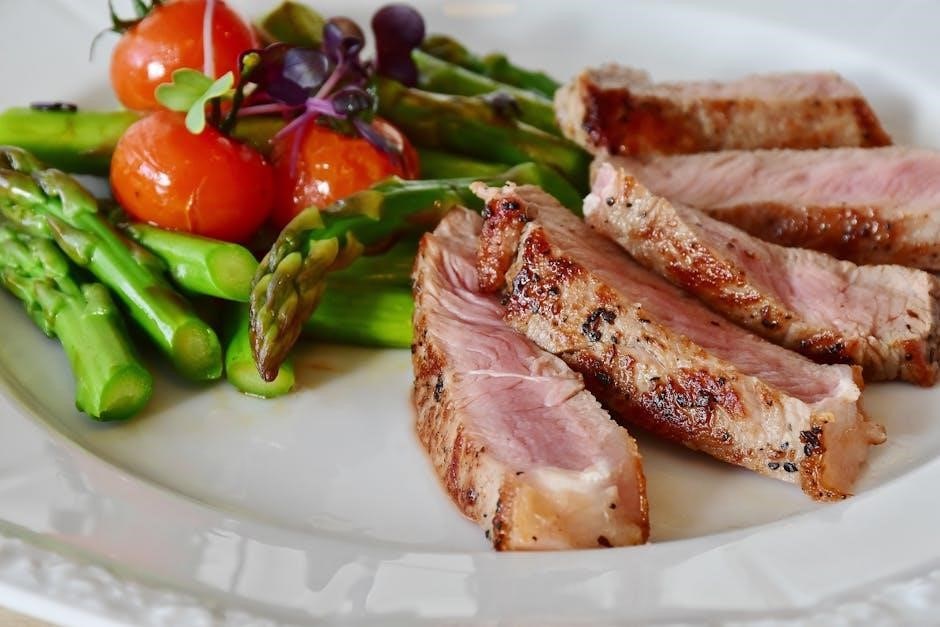Understanding Steak Cuts
Understanding steak cuts is key to making informed decisions. Popular cuts like ribeye, sirloin, and tenderloin vary in marbling, tenderness, and flavor. Ribeye is rich and juicy, while sirloin offers lean versatility. Tenderloin is the most tender, and strip steak balances marbling and flavor. Each cut’s unique characteristics ensure a tailored dining experience.
Popular Steak Cuts and Their Characteristics
Ribeye is known for its rich marbling, offering a buttery, savory flavor and tender texture. Filet Mignon is the most tender cut, lean and melt-in-your-mouth. Sirloin balances flavor and affordability, with a firmer texture. New York Strip combines marbling with a robust beefy taste. Each cut’s unique traits cater to different preferences, ensuring a personalized dining experience tailored to taste and occasion.
How to Choose the Right Cut for Your Taste Preferences
Matching the steak cut to your taste preferences ensures a satisfying meal. For rich, buttery flavors, opt for a ribeye or porterhouse. If tender texture is your priority, filet mignon or tenderloin are ideal. Those seeking bold beef flavor often prefer strip loin or sirloin. Consider marbling for juiciness and leanness for a heartier bite. Ask your server for recommendations to align the cut with your dining goals and flavor profile.
- Ribeye/Porterhouse: Rich, marbled, juicy.
- Filet Mignon: Tender, lean, mild flavor.
- Strip Loin/Sirloin: Balanced, robust beef taste.
Steak Cuts for Different Occasions
Choosing the right steak cut for the occasion enhances your dining experience. For formal events, filet mignon or tenderloin offer elegance and tenderness. Casual gatherings call for hearty cuts like ribeye or sirloin, rich in flavor and texture. For a romantic dinner, strip loin or porterhouse provide a luxurious touch. Opt for flank steak or skirt steak at barbecues for bold, robust flavors. Tailor your choice to the vibe and preferences of the occasion for a memorable meal.

Differences in Steak Doneness
Understanding steak doneness is crucial for a perfect meal. Levels range from rare to well-done, each offering a distinct texture and flavor. Medium-rare is often recommended for optimal tenderness and richness.

Levels of Doneness: Rare, Medium-Rare, Medium, Medium-Well, Well-Done
Steak doneness levels vary from rare to well-done, each offering a unique texture and flavor. Rare steaks are seared outside with a red, juicy interior. Medium-rare features a pink center, balancing tenderness and flavor. Medium has a slightly firmer texture with a hint of pink, while medium-well is mostly cooked through with minimal pink. Well-done steaks are fully cooked, offering a firmer bite. Understanding these levels ensures your steak is prepared to your liking, enhancing your dining experience.

Why Medium-Rare is Often Recommended
Medium-rare is often recommended for its optimal balance of flavor and texture. At this level, the steak retains its natural juices, enhancing tenderness and richness. The pink center ensures the meat stays succulent, while the outer sear adds a caramelized crust. Chefs and steak enthusiasts favor medium-rare as it highlights the steak’s natural qualities without overcooking, making it ideal for most cuts, especially high-quality options like ribeye or strip steak. This doneness level truly elevates the dining experience.
How to Communicate Your Doneness Preference to the Server
Clearly communicate your doneness preference by stating your desired level, such as “medium-rare” or “well-done.” If unsure, ask the server for guidance or clarification. Be specific about your preference, as this ensures the chef prepares your steak accurately. Some restaurants may also offer visual aids or descriptions to help you choose. Confirming your preference during ordering guarantees a tailored experience, allowing you to enjoy your steak exactly as you like it. This clear communication enhances your dining satisfaction and overall experience.
Cooking Methods for Steak
Steak can be grilled, pan-seared, or oven-roasted, each offering unique flavor profiles. Grilling adds smokiness, while pan-searing creates a crust, and oven-roasting ensures even cooking. Choose based on your preference and available tools for the perfect result.
Grilling, Pan-Seared, Oven-Roasted: What’s Best for Your Steak
Choosing the right cooking method enhances your steak experience. Grilling infuses smoky flavors and a charred crust, ideal for thicker cuts like ribeye. Pan-searing offers a crispy exterior and juicy interior, perfect for tender cuts like filet mignon. Oven-roasting provides even cooking, great for uniform doneness, especially for larger cuts. Each method brings out unique qualities, ensuring the perfect steak tailored to your taste and texture preferences.
The Role of Temperature in Cooking the Perfect Steak
Temperature is crucial for achieving the perfect steak. For medium-rare, cook to 130-135°F, ensuring a juicy interior. Medium requires 140-145°F, while medium-well reaches 150-155°F. Well-done is 160°F and above. Using a meat thermometer ensures accuracy. Preheating pans or grills properly sears the steak, locking in flavors. Cooking at the right temperature guarantees your steak is tender, flavorful, and cooked to your desired doneness, enhancing the overall dining experience.
Dry-Aged vs. Wet-Aged Steak: What’s the Difference?
Dry-aged steak is aged in a controlled environment, losing moisture to concentrate flavors, resulting in a rich, beefy taste. Wet-aged steak is aged in vacuum-sealed bags, retaining moisture and tenderness. Both methods enhance steak quality, but dry-aged offers a more intense flavor profile, while wet-aged ensures juiciness. Choosing between them depends on your preference for taste and texture, with dry-aged being a premium choice for a robust experience.
Factors Influencing Your Steak Choice
Marbling, grass-fed vs. grain-fed, and beef breeds significantly impact steak quality. Marbling enhances tenderness and flavor, while grass-fed offers leaner profiles. Breeds like Wagyu boast exceptional marbling for richness.
Marbling: Why It Matters for Flavor and Tenderness
Marbling, the flecks of fat within steak, is crucial for flavor and tenderness. It enhances juiciness and richness, creating a more luxurious dining experience. Higher marbling levels, as seen in Wagyu beef, deliver unparalleled tenderness and depth of flavor. Lean cuts, like sirloin, offer less marbling but remain tender with proper cooking. Balancing marbling preferences ensures a steak that suits your taste, whether you prefer richness or a leaner profile. This factor is key to enjoying the perfect steak.
Grass-Fed vs. Grain-Fed Beef: Which is Better?
Grass-fed beef, raised on pastures, offers a leaner profile with higher omega-3s and vitamins. It tends to have a stronger, earthier flavor. Grain-fed beef, finished on grains, is typically richer and more marbled, enhancing tenderness and flavor complexity. The choice depends on your preference: grass-fed for a more natural, nuanced taste or grain-fed for a bolder, indulgent experience. Both options deliver quality, but the difference lies in taste and nutritional profile.
Understanding Beef Breeds and Their Impact on Steak Quality
Beef breeds significantly influence steak quality, with variations in marbling, tenderness, and flavor. Angus cattle, known for their marbling, produce rich, juicy steaks. Wagyu beef, renowned for its intense fat content, offers unparalleled tenderness and umami flavor. Hereford and Simmental breeds balance marbling with lean muscle, resulting in robust yet approachable steaks; Understanding these breed differences helps diners select steaks that align with their taste preferences, ensuring a more satisfying culinary experience.
Pairing Steak with Sides and Wine
Steak pairs perfectly with classic sides like garlic butter potatoes and grilled vegetables, while wines like Cabernet Sauvignon complement rich flavors, enhancing the dining experience.
Classic Side Dishes That Complement Steak
Classic side dishes like garlic butter potatoes, grilled vegetables, and sautéed mushrooms perfectly complement steak, enhancing its rich flavor. Creamy spinach and roasted root vegetables add a delightful contrast in texture. Sides like truffle mac and cheese or loaded baked potatoes elevate the meal, while a simple salad provides a refreshing balance. These options ensure a well-rounded and satisfying steakhouse experience, catering to various tastes and preferences.
Wine Pairing 101: Red, White, or Something Else?
When pairing wine with steak, red wines like Cabernet Sauvignon or Malbec are classic choices, complementing bold, fatty cuts. For leaner steaks, a Pinot Noir offers a lighter touch. White wines, though less traditional, can work with lighter dishes or sauces. Ultimately, personal preference reigns, but asking your server for pairing suggestions ensures a harmonious match, enhancing your steakhouse experience with every sip.
How to Balance Flavors in Your Steakhouse Meal
Balancing flavors in your steakhouse meal involves harmonizing rich meats with complementary sides and seasonings. Pair bold steaks with earthy vegetables or creamy sauces to offset their intensity. Acidic elements like citrus or red wine reductions can cut through fattiness, while herbal notes enhance natural beef flavors. Seasonings should enhance, not overpower, the steak’s inherent taste. Consider the marbling and doneness when selecting sides to create a well-rounded, satisfying dish that delights the palate.

Budget Considerations
Opt for affordable cuts like sirloin or flank steak, which offer great flavor at lower prices. Consider value over premium options and explore promotions or happy hour deals.
How to Order Steak on a Budget
Ordering steak on a budget requires strategic choices. Opt for cuts like sirloin or flank steak, which are flavorful and affordable. Avoid premium options like ribeye or filet mignon to save money. Consider smaller portions or sharing plates. Look for happy hour specials or lunch menus, where steaks are often discounted. Skip expensive sauces and sides to keep costs low. Additionally, dining during off-peak times can offer better value without compromising on quality.

Are Expensive Steaks Worth the Price?
Expensive steaks often justify their cost through quality and exclusivity. Premium cuts like filet mignon and A5 Wagyu offer unparalleled tenderness and rich flavor profiles. These steaks are sourced from top-tier breeds and production methods, ensuring superior taste and texture. While budget-friendly options satisfy basic cravings, luxury steaks provide a unique culinary experience. For special occasions or to indulge, they are worth the investment, delivering a memorable dining experience that reflects their high quality and craftsmanship.
Tips for Getting the Best Value at a Steakhouse
To maximize value at a steakhouse, consider ordering during lunch or happy hour for reduced prices. Sharing larger cuts like a porterhouse can also lower costs. Opting for bone-in steaks, which are often cheaper than boneless, ensures flavorful meals. Additionally, skipping expensive sides and focusing on the steak itself can enhance your experience without overspending. Prioritizing quality over quantity and being mindful of portion sizes further ensures a satisfying yet economical dining experience.

Advanced Tips for Ordering Steak
Advanced steak ordering involves balancing flavor and texture. Opt for bone-in cuts like ribeye for enhanced richness or boneless striploin for tenderness. Don’t overlook dry-aged options for depth, and always inquire about origin and marbling for optimal quality. Elevate your experience by requesting specific seasoning preferences and pairing with complementary sauces or sides for a refined meal.
When to Choose Bone-In vs. Boneless Steaks

Choosing between bone-in and boneless steaks depends on your preference for flavor and texture. Bone-in steaks, like ribeye or T-bone, offer enhanced flavor and moisture due to the bone’s natural insulation. They’re ideal for those seeking a richer, more robust dining experience. Boneless cuts, such as striploin or filet mignon, provide easier portion control and even cooking. Opt for boneless if you prefer a leaner, more tender bite. Bone-in is best for hearty, indulgent meals, while boneless suits refined, hassle-free dining.
How to Ask for Seasoning and Sauce Preferences
When ordering steak, clearly communicate your seasoning and sauce preferences. Ask if the steak is pre-seasoned or if you can request specific seasonings. For sauces, inquire about available options like Béarnaise, peppercorn, or chimichurri. Specify if you want the sauce on the side or drizzled on the steak. Some steakhouses offer signature sauces, so don’t hesitate to ask for recommendations. Clear communication ensures your steak is tailored to your taste, enhancing your dining experience.
Interacting with Your Server: Questions to Ask
When interacting with your server, ask questions to ensure a personalized dining experience. Inquire about the steak’s origin, aging process, and breed for quality insights. Ask for recommendations on cuts that suit your taste preferences. Clarify cooking temperatures and doneness levels to avoid undercooked or overcooked steak. Also, inquire about any house specialties or seasonal offerings. Engaging with your server enhances your meal and ensures you make the best choice for your palate and preferences.
Understanding steak cuts, doneness, and cooking methods ensures a perfect steakhouse experience. Confidently order your ideal steak, enhancing your enjoyment of this culinary delight.
Final Tips for a Perfect Steakhouse Experience
To elevate your steakhouse experience, research the restaurant beforehand and ask your server for recommendations. Arrive early to enjoy pre-dinner drinks and appetizers. Trust the chef’s expertise and consider their seasonal specials. Don’t hesitate to inquire about the origin and aging process of the steak. Balance your meal with complementary sides and wine pairings. Communicate your preferences clearly, ensuring your steak is cooked to your liking. Savor each bite mindfully, making the most of your culinary journey.
Key Takeaways for Ordering the Best Steak
When ordering steak, prioritize understanding cuts and their characteristics. Opt for medium-rare for optimal flavor and tenderness. Ask your server about the steak’s origin, aging process, and marbling. Don’t hesitate to inquire about cooking methods and seasoning preferences. Balance your meal with complementary sides and wine pairings. Clearly communicate your doneness preference and trust the chef’s expertise. By combining these strategies, you’ll elevate your dining experience and enjoy a perfectly tailored steak.

